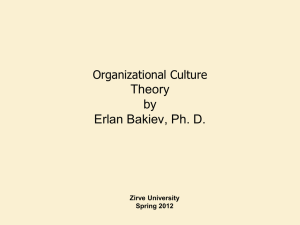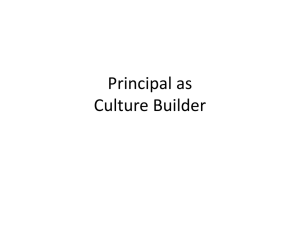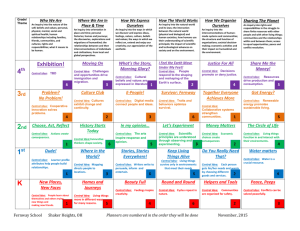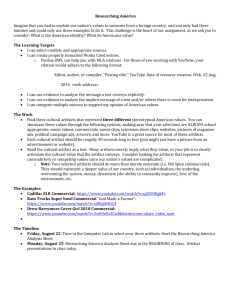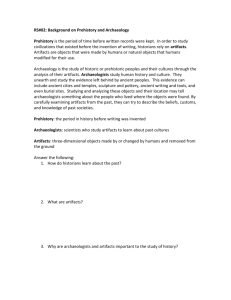Rituals, traditions and artifacts provide a window in the beliefs and
advertisement
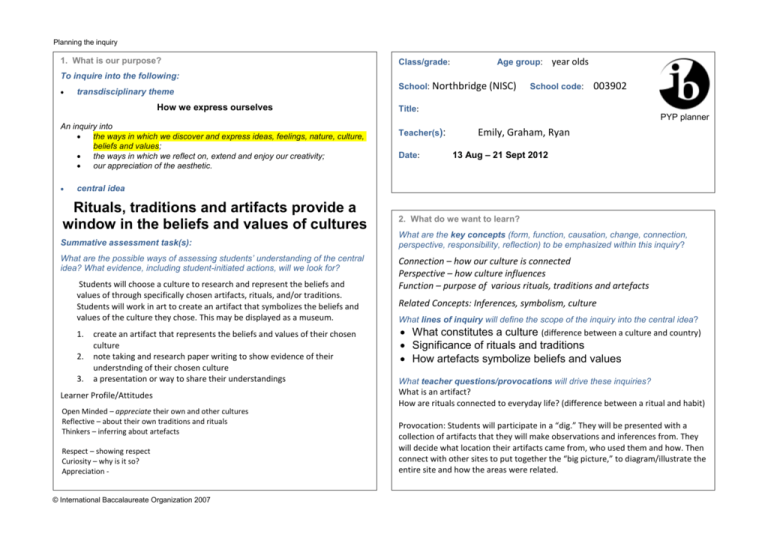
Planning the inquiry 1. What is our purpose? Class/grade: Age group: year olds To inquire into the following: transdisciplinary theme How we express ourselves An inquiry into the ways in which we discover and express ideas, feelings, nature, culture, beliefs and values; the ways in which we reflect on, extend and enjoy our creativity; our appreciation of the aesthetic. School: Northbridge (NISC) School code: 003902 Title: Teacher(s): Date: PYP planner Emily, Graham, Ryan 13 Aug – 21 Sept 2012 central idea Rituals, traditions and artifacts provide a window in the beliefs and values of cultures Summative assessment task(s): What are the possible ways of assessing students’ understanding of the central idea? What evidence, including student-initiated actions, will we look for? Students will choose a culture to research and represent the beliefs and values of through specifically chosen artifacts, rituals, and/or traditions. Students will work in art to create an artifact that symbolizes the beliefs and values of the culture they chose. This may be displayed as a museum. 1. 2. 3. create an artifact that represents the beliefs and values of their chosen culture note taking and research paper writing to show evidence of their understnding of their chosen culture a presentation or way to share their understandings Learner Profile/Attitudes Open Minded – appreciate their own and other cultures Reflective – about their own traditions and rituals Thinkers – inferring about artefacts Respect – showing respect Curiosity – why is it so? Appreciation - © International Baccalaureate Organization 2007 2. What do we want to learn? What are the key concepts (form, function, causation, change, connection, perspective, responsibility, reflection) to be emphasized within this inquiry? Connection – how our culture is connected Perspective – how culture influences Function – purpose of various rituals, traditions and artefacts Related Concepts: Inferences, symbolism, culture What lines of inquiry will define the scope of the inquiry into the central idea? What constitutes a culture (difference between a culture and country) Significance of rituals and traditions How artefacts symbolize beliefs and values What teacher questions/provocations will drive these inquiries? What is an artifact? How are rituals connected to everyday life? (difference between a ritual and habit) Provocation: Students will participate in a “dig.” They will be presented with a collection of artifacts that they will make observations and inferences from. They will decide what location their artifacts came from, who used them and how. Then connect with other sites to put together the “big picture,” to diagram/illustrate the entire site and how the areas were related. Planning the inquiry 3. How might we know what we have learned? 4. How best might we learn? This column should be used in conjunction with “How best might we learn?” What are the learning experiences suggested by the teacher and/or students to encourage the students to engage with the inquiries and address the driving questions? What are the possible ways of assessing students’ prior knowledge and skills? What evidence will we look for? Difference between observation and inference through observations/notes from Personal artifacts, Tracks and Portrait/Photo Study. What are the possible ways of assessing student learning in the context of the lines of inquiry? What evidence will we look for? What constitutes a culture (difference between a culture and country) Cultural matrix and venn diagram comparisons. Significance of rituals and traditions Cultural matrix, sorting of rituals and traditions from beliefs and values, looking at connections between rituals traditions and cultures through research and teacher led case study. How artefacts symbolize beliefs and values Through the research, formation and creation of their artifact in art. Personal artifacts – bring from home other students make observations then inferences about the item and it’s significance to the owner, the owner then shares Tracks – Power Point slides of two tracks are shown. Students make observations then inferences from the image. A second slide is shown showing what the two tracks do next, further observations then inferences. And finally a third slide with the next part of the picture story, final observations then inferences. Discuss the importance of observing and questioning and the possibility of various conclusions. Portrait Study – A historical portrait is shown. Students use visual clues/observations to begin inferring the role of the individual. Importance of Context – Pictures of pottery pieces, an old oil lamp, the lamp with a wick then the lamp with the wick and oil on fire. Students see the pictures progressively inferencing what the object might be and might be used for, with each new photo they will get closer to the answer seeing further context clues. Importance of Connections/Research – (literacy connection) Students are given photos of artifacts found at the Jamestown site. They observe and infer the purpose of each artifact. Then they are given descriptions of the items, cards filled with research. They re-assess their original conclusions then use the new information to write a historical fiction account of the artifact and who owned it. Guided Case Study – Teacher led exploration of a culture and how it’s beliefs and values are represented through the artifacts, rituals, and traditions. Library – Lesson on primary and secondary sources as well as research techniques/strategies including google image scanner. Art – Making inferences about symbolism and culture through art artifacts. Extending to create an artifact from the chosen culture for the summative assessment. 5. What resources need to be gathered? What people, places, audio-visual materials, related literature, music, art, computer software, etc, will be available? Media: Around the World in 80 Treasure, The Gods Must be Crazy, A day in the Life of… How will the classroom environment, local environment, and/or the community be used to facilitate the inquiry? Interviewing families about their cultural beliefs and values. Field trip to Sovanna Phum and Beirut. © International Baccalaureate Organization 2007 What opportunities will occur for transdisciplinary skills development and for the development of the attributes of the learner profile? Open Minded – appreciate their own and other cultures Reflective – about their own traditions and rituals Thinkers – inferring about artefacts Respect – showing respect Curiosity – why is it so? Appreciation - Reflecting on the inquiry 6. To what extent did we achieve our purpose? 7. To what extent did we include the elements of the PYP? Assess the outcome of the inquiry by providing evidence of students’ understanding of the central idea. The reflections of all teachers involved in the planning and teaching of the inquiry should be included. What were the learning experiences that enabled students to: Cultures value things like teamwork, independence, freedom. – Vattey Studnets choice of artifacts showed that they understood beliefs and values of cultures. Chira made a shoes from the Greek culture to show their importance of speed and gods who represent speed. He also reflected on how much of our culture is influenced by Greek culture. i learn that cultures are not crazy they are just doing and obey their culture. i would not think there culture are funny or crazy again b/c i learn they are awesome. – Hao i learned about the french revolution. i learned they believe in justice, egalitarianism, and brotherhood. – Kanhna Even though I don’t believe in that (Aztec culture of violence) I didn’tlaugh at their ideas. - Jeano learning a/b cultures helps me be open minded to other people no matter skin color or country. also culture makes me want to kow more a/b it so i can meet new people. – Roxy After having done the first three units we noticed a lot of evidence of students ‘ making strong connections between the three units. They also refined their skills such as researching, thinking, and self management. We purposefully planned the units in this order and thought about skill building to achieve these results. How you could improve on the assessment task(s) so that you would have a more accurate picture of each student’s understanding of the central idea. It was big but having the time to work with Kelli (art) proved to be effective. We planned to have 8 weeks in order to have this time. What was the evidence that connections were made between the central idea and the transdisciplinary theme? people express their culture by speaking ter language and doing traditions. rituals show beliefs and values. artifacts show traditions from everyday. - Roxy eiffel tower shows French values of fairness and justice. – James peple express beliefs in culture by praying, celebrations, artifacts. rituls traditions and artifacts show a culture. - Janey © International Baccalaureate Organization 2007 develop an understanding of the concepts identified in “What do we want to learn?” We focused more on related concepts in this unit. We looked at the key concepts through the lens of the related concepts. Connection – how our culture is connected Perspective – how culture influences Function – purpose of various rituals, traditions and artefacts Related Concepts: Inferences, symbolism, culture Inferences: dig simulation, tracks, photo study, traditional story read alouds, researching Symbolism: colors, images, and other items that are symbolic in mamy cultures, Culture: the whole unit was about culture, each learning experience helped build the foundation of knowledge demonstrate the learning and application of particular transdisciplinary skills? Research: note taking, note card compilation, outlines, writing Self management: making a plan for research and folloing through Thinking: through learning experiences scaffolding the idea of inferencing Communication: this was not developed as well Social: learning how other people with their beliefs can also be right Reflecting on the inquiry 8. What student-initiated inquiries arose from the learning? 9. Teacher notes Record a range of student-initiated inquiries and student questions and highlight any that were incorporated into the teaching and learning. 4/5 EO Rituals Traditions and Artifacts. It was research heavy and a good way to front load skills for the remainder of the year. Be sure to scaffold for note taking, main ideas, researching etc. Working with notecards and outlines really helped structure the research. Studenst followed their own inquiries into cultures. They wrote research questions, answered their own inquiries and made an artifact to show what they had learned. why does the world have different countries and who named each country? Piseth who made people? - Juho Studnens were confused between culture and country as were many adults be careful when teaching this. At this point teachers should go back to box 2 “What do we want to learn?” and highlight the teacher questions/provocations that were most effective in driving the inquiries. Stories worked as the kids could identify what the culture valued. What student-initiated actions arose from the learning? Record student-initiated actions taken by individuals or groups showing their ability to reflect, to choose and to act. Piseth made Roman food at home. This inspired Mousty to do the same. Carla read stories from Egypt and found the values and beliefs within. She shared this for her summative. Studnets brought in books and artifacts from home to share new cultures and their beliefs and values. © International Baccalaureate Organization 2007 Studnets need to learn to make connections. Ancient civilizations – because it was static. Researching a present day culture was more difficult because it is still in flux and has less concrete resources. Don’t have a lot of cultural difference in the classroom – how do we get kids. Easier to understand archeology than anthropology.
